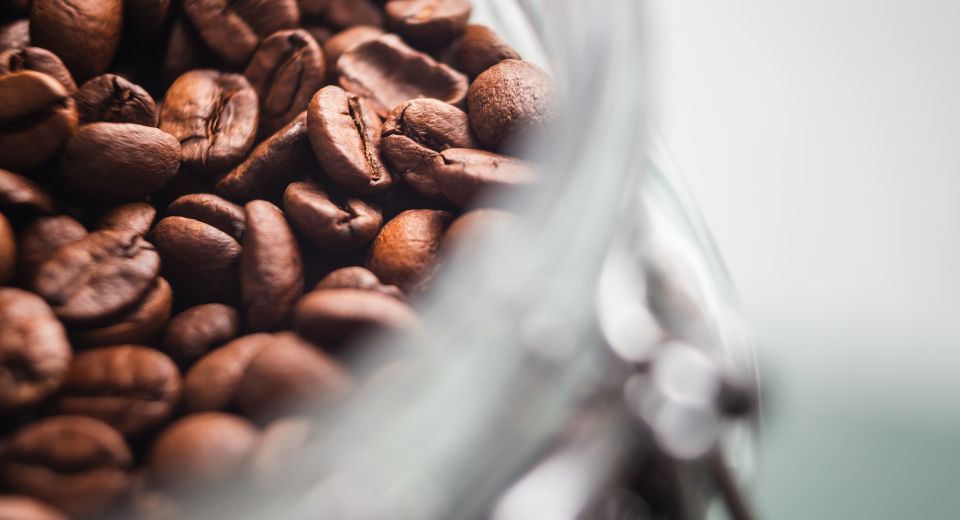How To Store Coffee Beans – The Best Way To Keep Them Fresh

Coffee is a delicious hobby, but it can also be an expensive one. Learning how to store coffee beans will keep you from wasting your prized coffee beans.
Just like any other food, coffee beans need to be protected from elements such as light exposure or temperature changes. While you may be tempted to toss them into a spare mason jar and call it a day, I’m here to give you more effective tips.
I’ll show you how to store coffee beans to protect their subtle flavor notes, aroma, and mouthfeel. You’ll also learn the important differences between storing green coffee, roasted coffee, and ground coffee.
What is the Best Way to Store Whole Roasted Coffee Beans?
The moment roasters start roasting green coffee, the clock starts ticking. Every day your whole coffee beans will gradually lose flavor through degradation.
Storing your whole coffee beans properly will slow this natural process down as much as possible. If you want to buy a little extra time in-between coffee purchases, this knowledge is (ironically enough) priceless.
Remember Their Natural Time Limit
How long do you store whole coffee beans? The most reliable time limit is between eight to twelve months in the long term.
I personally don’t like to keep a bag of whole beans longer than a month or two. A good habit to develop is only buying as much coffee as your lifestyle needs. Since I drink coffee a few times a week, I usually go through a standard 12oz bag in three to four weeks.
Keep Coffee Away From Extreme Temperatures
Never store your whole beans in a very cold or very hot area. Both temperature extremes cause different types of damage.
A very hot area will cause your coffee to lose flavor faster. After all, heat is part of the brewing process, isn’t it? You want to save heat for when you’re making a latte, not for long-term storage.
An area that’s too cold creates another type of risk. If your coffee develops even a little moisture, the combination of moisture and cold in an enclosed area increases the risk of mildew. Mildew is closely related to mold and can cause health issues such as upset stomach, asthma, or allergic reactions.
In fact, if you ever suspect coffee is moldy? Toss it to be on the safe side.
Always Keep Them in an Airtight Container
Oxygen exposure also breaks down the flavor compounds in your coffee. Just like leaving a slice of bread out on the counter will make it dry and stale, so too will your whole beans struggle.
Airtight containers are easy to find and will give you an even better result than pinning your coffee bag closed. Some containers also come with opaque designs to keep light out.
Speaking of which…
Keep Coffee Away From the Light
While coffee-filled mason jars lining the kitchen counter is a charming image, it’s not a great storage idea. You need to keep your coffee away from light exposure to reduce oxidation.
Have you ever noticed how an apple or a banana will turn brown when you cut them? This browning process is called oxidation, a side-effect of being exposed to air and light. While small amounts won’t affect the flavor too much, too much oxidation will turn your coffee stale.
If you want to use a glass jar, store it in a cool, dark part of your pantry. At the very least, glass is a good material for protecting coffee’s flavor.
What is the Worst Way to Store Whole Coffee Beans?

Now that you know how to store whole coffee beans, let’s take a look at what actions to avoid.
Never Store Coffee Beans in the Fridge
Storing coffee beans in the fridge is a surefire way to ruin your purchase. The combination of cold temperatures and the increased possibility for moisture will just turn your coffee into mildew central.
Moldy coffee isn’t just terrible tasting: it’s bad for your health.
Try Not to Leave Whole Coffee Beans in Your Grinder
Do you sometimes forget to grind your whole beans after putting them in the grinder? While forgetting them for a few days won’t ruin your purchase, exposing them repeatedly to air compromises flavor.
Many grinders also have clear lids so you can see how much coffee is inside, which then exposes your purchase to light. As you can imagine, this causes more oxidation and therefore less flavor.
Try to build up the good habit of grinding and brewing your beans as quickly as possible.
What is the Best Way to Store Ground Coffee?

Ground coffee has much less wiggle room than whole beans. Since you’ve already broken them down into more fragile parts, they become stale much faster.
Use an Extra Airtight Container
A regular jar won’t do for ground beans. If you want to fight nature and keep your ground coffee as flavorful as possible, I recommend an extra airtight container with an accordion seal.
Accordion seals are useful because they keep out air to an extreme degree and also protect against moisture build-up. Some containers come with additional features to block out light and temperature changes, such as the MiiR Airtight Coffee Canister. This durable coffee container covers all your bases and is a great addition to hiking and traveling.
Don’t Store Ground Coffee For Long
There’s only so much you can do against ground coffee’s desire to turn into flavorless dust. Try not to store ground coffee for more than two or three days in an extra airtight container.
What is the Worst Way to Store Ground Coffee?

It’s time to develop some good coffee habits! Storing ground coffee is trickier than storing whole beans due to degrading faster.
A Plastic Bag or Paper Bag
If you’re low on coffee supplies, you may be tempted to use a plastic or paper bag to keep your grounds. These aren’t nearly as airtight as a dedicated coffee container and won’t do much to maintain freshness.
Placing Ground Coffee On or Near a Window
You might not think much of putting your coffee on a windowsill, but this act is a double blow to freshness. Not only are you exposing your coffee to light, you might also expose it to air and any critters thinking of crawling through the windowpane.
Placing Ground Coffee Above Your Oven
Do you have a pantry right above your oven? Keep coffee away from there, as heat can still seep through the bottom and expose your coffee to temperature changes.
The best place to store your coffee is any cool, dark pantry away from open windows, your oven, or light exposure.
What is the Best Way to Store Green Coffee?

Last but not least, we have the subtle details of storing green coffee beans. Whether you like to roast coffee from home or want to try green coffee smoothies, don’t overlook these tips!
Freeze Your Coffee in Vacuum Seal Bags
Do you want to keep green coffee in the long term? Freezing green coffee in vacuum seal bags is a great way to maintain freshness for up to two years.
You can purchase green coffee already vacuum sealed or purchase a vacuum sealing machine yourself.
An Airtight Container In a Cool, Dry Place
Green coffee isn’t nearly as fragile as roasted ground coffee, so you don’t necessarily need an extra airtight container. A glass jar or a standard coffee container will do the trick.
Just make sure you store your beans somewhere cool, dry, and away from any light. Green coffee will remain stable for six to twelve months when stored properly.
What is the Worst Way to Store Green Coffee?

This last section is very straightforward: most of the same rules that apply to roasted coffee and ground coffee apply to green coffee. Keep them in an airtight container, don’t expose them to light, and never refrigerate them!
That said, I have a few extra tips you might be overlooking.
Don’t Leave Green Coffee Out in the Open
If you’re thinking of using green coffee in a recipe such as smoothies or a mocktail, don’t leave them out in the open. While green coffee is a little more durable than roasted or ground, it’ll still lose flavor when sitting out on the counter.
Don’t Dump Green Coffee With Other Food
Green coffee is a sensitive material that can sometimes take on the flavors of what’s around it. To maintain its subtle grassy and herbal flavors, don’t dump green coffee together with other food.
The only time green coffee should even touch other food is right before you blend everything together.
How To Store Coffee Beans – FAQs
Still got a few questions about storing coffee beans? I’ll answer several below so you can get the most out of your purchase.
Is it Okay to Store Coffee Beans in Tupperware?
I recommend dedicated Tupperware over a plastic bag any day. Just make sure to put your whole beans in a cool, dark part of your pantry.
Is Glass or Plastic Better For Storing Coffee?
When in doubt, go with glass. While plastic can be fine for short-term storage – such as a few days to a week – glass is better for the long term.
Glass is a non-absorbent material that won’t affect the flavor of your coffee.
Can I Store My Coffee in a Mylar Bag?
While I don’t recommend plastic or paper bags for storing coffee, mylar bags are a different story. These bags have a metallic sheen and are made from a polyester resin.
Mylar bags are not only ideal for storing fragile materials such as electronics, but they’re also prime for storing coffee beans. They’re resistant to temperature changes, particularly extreme heat, and keep pesky microorganisms at bay.
You can buy packs of mylar bags and use them for whole beans or ground coffee.





